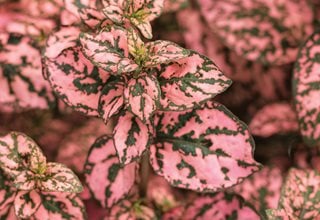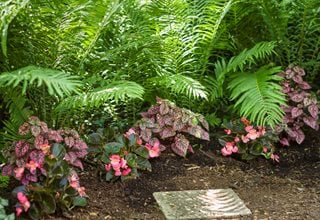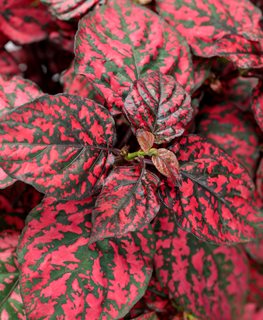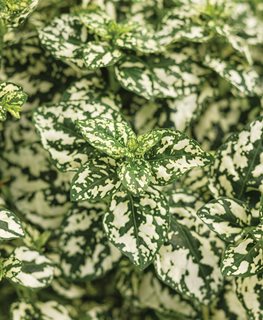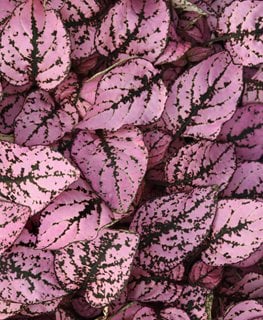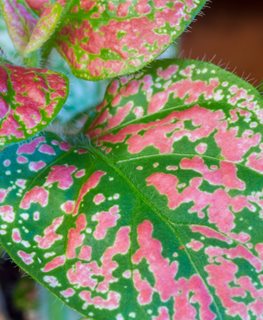POLKA DOT PLANT - GROWING TIPS, DESIGN, AND DISPLAY IDEAS
Learn how to brighten up your home and garden with this charming, easy-to-grow foliage plantPlants can be the ultimate mood lifters, especially when they are as cheery and colorful as the polka dot plant. Easily recognized by its pink-speckled dark green leaves, this perky little plant can also be found in other bright color combos and patterns. Instead of pink, the spotted leaves may be accented with red, white, or deep rose. And some newer cultivars don’t have dots at all, but instead sport showy splash-patterned or marbled leaves with distinctive green veining.
Because polka dot plants are native to a tropical climate, they thrive in warm indoor environments. But given the right conditions, you can also grow them outdoors as eye-catching accent plants in garden beds, borders, and containers.
On this page: Basics | Planting | Care | Pictures | Design & Display Tips
THE BASICS
Botanical name:
Hypoestes phyllostachya (formerly Hypoestes sanguinolenta)
Common names:
Polka dot plant, pink polka dot plant, measles plant, freckle face, splash plant
Plant type:
Tender perennial
Zones:
10-11; grown as an annual or indoor plant in most regions
Height:
6 to 18 inches
Exposure:
Bright, indirect light is ideal
Growth rate:
Fast
Special attributes:
- Non-toxic to cats & dogs
- Noninvasive
- Deer resistant
- Rarely bothered by pests
GROWING POLKA DOT PLANT
In general, hypoestes plants are easy to grow and trouble-free, but there are a few essential conditions they need to thrive. Here are four basic requirements to keep them healthy.
1. Give them warmth and humidity.
Polka dot plant grows best at warm temperatures and high humidities.- Indoors: When growing indoors, keep your plant in a room with an average air temperature of 70° to 75°F and a minimum humidity level of 50%. If you need to the raise humidity, you can mist the leaves or place the pot on a tray filled with pebbles.
- Outdoors: Plants grown outdoors need similar conditions and shouldn’t be placed in the garden until late spring, after temperatures have warmed up and the threat of frost has passed.
2. Water regularly.
Keep soil consistently moist, but not soggy. Too little water will cause the leaves to wilt and too much can cause root rot. When growing outdoors in beds, make sure they are in a location with good drainage. When growing in containers, use pots with good drainage. As houseplants, they will need more water than others such as snake plant or philodendron.3. Fertilize often.
Polka dot plants have a hearty appetite and are happiest when fertilized regularly. To promote lusher growth, feed container-grown plants every 2 weeks during the active growing season with a well-balanced liquid fertilizer and less frequently (about every other month) during the fall and winter. In-ground plants will benefit from the application of a slow-release all-purpose plant food.4. Avoid direct sunlight.
Polka dot plants will have the best leaf color if you give them bright light but keep them shaded from direct sun outdoors, which can scorch the leaves and cause the color to fade. Indoors, place your plants in bright, filtered sunlight of an east- or west-facing window and rotate the plant regularly. Outdoors, grow them in partial sun to full shade.POLKA DOT PLANT CARE
Pruning:
Polka dot plants grow quickly and tend to get leggy without regular pruning. To encourage fuller growth and maintain the desired shape and size, pinch back the stem tips periodically throughout the growing season. Also pinch off any flower spikes that may develop. They offer little ornamental value and will detract from the foliage.
Overwintering:
If you live in a climate with cold winters and plan to grow your polka dot plants outdoors, it’s best to treat them as annuals or put them in containers or pots that you can bring indoors in the fall. They will not tolerate temperatures below 60° F.
Diseases and pests:
Plants are susceptible to powdery mildew and root rot when overwatered. Also keep an eye out for whiteflies, aphids, and spider mites.
Troubleshooting:
The leaves of a polka dot plant are the best barometers of its health.
- If the foliage color is fading, move your plant to a location with brighter light (but away from direct sun).
- Leaves that begin to turn yellow are usually a sign of overwatering.
- If the leaves droop, your plant is thirsty and needs more frequent watering.
- Curled-up or scorched leaves are often caused by too much sun exposure.
Why is my polka dot plant flowering?
If plants dry out or when days get shorter in fall and winter, they may start to flower. Unfortunately, this usually leads to the decline of the plant.
POLKA DOT PLANT PICTURES
DESIGN & DISPLAY TIPS
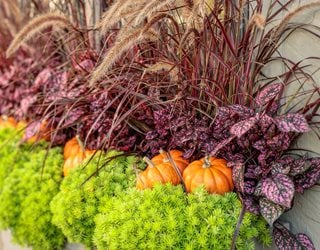
Window box with Hippo® Rose, Lemon Coral® sedum, and Graceful Grasses ® purple fountain grass. Photo by Proven Winners.
There are many ways to incorporate polka dot plants into your home or landscape. Here are a few:
- Tuck into a planter with other foliage or flowering plants to add a burst of color and textural contrast. For ideas, see these container combinations using the Hippo® series of polka dot plants from Proven Winners.
- In garden beds, polka dot plants are most effective in mass plantings, either as a groundcover, at the front of the border, or as an edging plant along shaded walkways.
- Because they grow best in filtered shade, use them as underplantings beneath a canopy of taller plants or shrubs.
- Polka dots plants are wonderful additions to terrariums and dish gardens, combined with other foliage plants that thrive in a humid environment. Frequent pinching will keep them in scale with their slower-growing companions.
RELATED:
Annual Flowers
Amazing Annuals for Sun
24 Purple Flowers to Brighten Your Garden
How to Create a Container Planting
